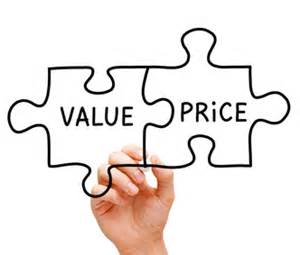
02 Feb From fixed fees to value pricing in 6 simple steps
So you’ve made the jump to fixed fees. Congratulations!
Does that feel good? Wasn’t that painful really was it – and your clients love it!
But are you really making the most out of the jump to fixed fees? Are you genuinely maximising your potential profit and simultaneously increasing client appreciation and recognition of the value of your work? That’s real value pricing – charging more and getting clients to feel good about it.
Yes it is possible, and it doesn’t even require any mystic alchemy – just some courage and skills development.
So, are you a real value pricer? How do you score on the following 6 questions?
1) Do you offer menu prices, or tailor an individual price for each new piece of work?
A house purchase for $750. A will for $150. A will and EPA for $250. With menu pricing you are commoditising your offering and encouraging people to go down the road and find somebody who can do it cheaper. If it’s the same price for everyone, it must be ‘off-the-shelf’. As there’s no discussion re price, there’s no discussion re value – and this prompts low value recognition and downward pressure on fees.
2) Do you charge a premium on top of the estimated time cost?
Clients value price certainty – and are willing to pay for it. If you offer client a choice between a no-guarantee, high-risk estimate, and a fixed fee at a slightly higher level, they will usually go for the fixed fee. When setting your fees, therefore, you should look to charge an invisible premium (15%?) on top of estimated time costs to reflect the client value of you accepting the risk.
3) Do you invest extra time in client conversations identifying and discussing client objectives and client value?
To charge value-based prices, you need to get clients to focus on their objectives and the related value, rather than your fees or time. Ask specific questions that establish client objectives and value. What would success look like? What would failure mean? Fuel their ambitions or build the pain! This activity is essentially ‘selling’, and not all lawyers are instinctively great at it, but skills can be learned and developed, and it’s certainly worth the investment.
4) Do you collaborate on scope and offer alternative scope/price options?
Scope discussions are great ways to communicate the value of your work. Talk about what you’re doing, why you’re doing it, the risks of not doing it, the risks of not doing it this way, and how all this benefits the client. Discuss which activities will be most valuable – and be ready to change your approach if you can’t convince the client of the value of different activities. These discussions, if managed well, will build client recognition of the value of your work and will usually result in increased scope and a higher value file. Try to avoid ‘take it or leave it’ retainer letters or costs agreements. Instead, work together and craft a solution that genuinely maximises acknowledged client value.
5) Do you demonstrate good costs conscious behaviours?
I’m talking about trust. Can you act and behave in a way that makes clients trust you in terms of what needs to be done and how you charge for it? Are you focused on their value for money, or maximising your own fees? If you can win their trust through good costs-conscious behaviours, this will significantly reduce their price sensitivity, leaving you scope to value-price more confidently.
and finally . . . .
6) Do you price on client value – or are you still tied to time and materials
If you have scored well so far, you may be ready for the final step.
Understanding the internal costs of producing work is important, and you should be careful that your prices never fall below a genuinely profitable level. This can often happen if law practices fix prices according to a perceived market price, and for instance offer wills for $150, when it costs the practice $200+ to produce them.
Beyond that, however, true value pricing – and the opportunity to generate significant profits – requires cutting the cord to time costing and genuinely pricing according to what the client is happy to pay. This means pricing the client, pricing on outputs not inputs, pricing according to the value you have created for the client. If the potential client value is higher on some matters (for whatever personal, financial or strategic reasons), your price should be looking to reflect that value.
How did you score? Are you a real value pricer?
To learn more, register now for one of the following workshops:
- 7 habits of highly effective solicitors, – full day workshop, March 15, Brisbane
- Power pricing & productivity (= profits), – half day workshop, March 16 (PM), Brisbane
- Re-boot your practice – half day workshop, March 16 (AM), Brisbane



Sorry, the comment form is closed at this time.